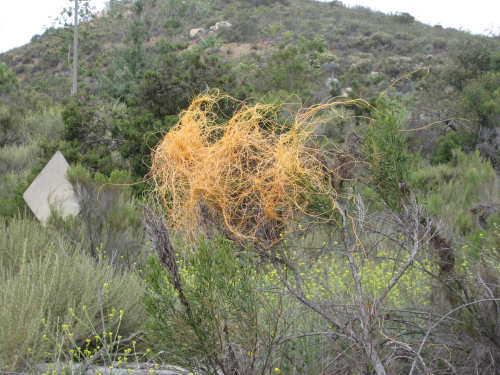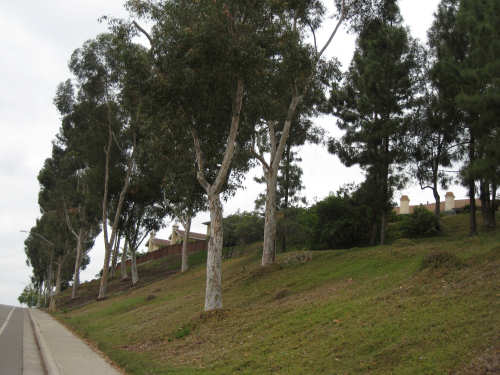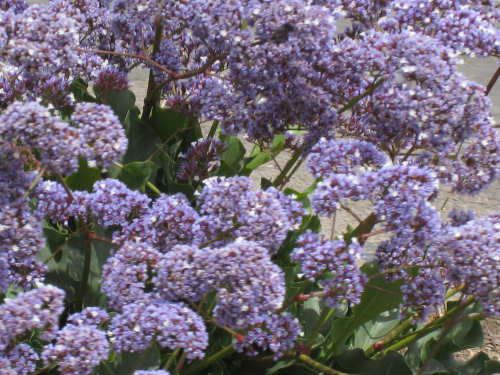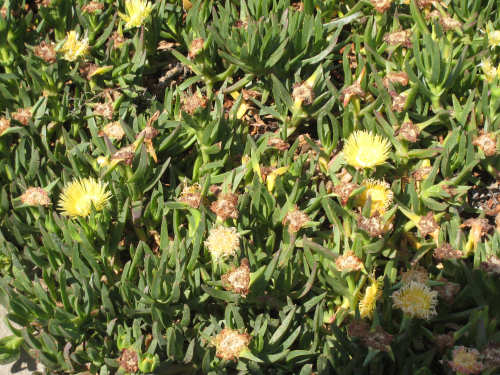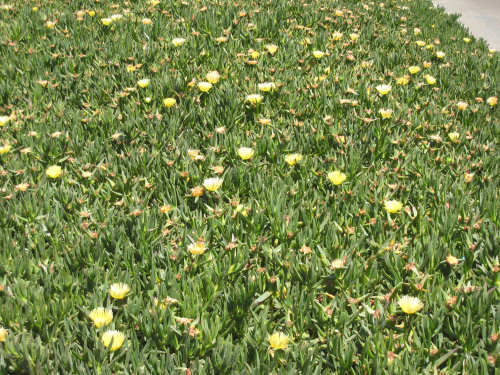Wednesday, May 21, 2008 - Rest Day in Santa Maria, CA
Today was a rest day and we didn't take any pictures, so I thought I'd use this opportunity to update you with information sent in by our faithful and knowledgeable readers. First, Pat's daughter, Sarah, tells us that the orange plant that looked parasitic actually is. She says it's called dodder and she writes "The stuff is barely a plant as it does not photosynthesize. It is a parasite of plants and has no roots. It gets all of its nutrients from the plants it wraps around. It can be a problem if it gets too overgrown as it tends to kill the local vegetation but usually isn't a big problem."
Pat's niece, Shane, tells us the gnarly trees we've seen are eucalyptus. As she says, "Eucalyptus trees - the bane of California envirnomentalists, though they smell great and look lovely. They're from Australia. The story goes that they were imported here to be grown for lumber, but either they brought the wrong variety or something in the soil here caused them to grow all wonky (I'm not sure which) and as a result they grow in a spiral. They're completely useless for lumber and their leaves make the soil around their base unsuitable for most native CA plants, apparently. Still, passing through a grove of them is pretty fabulous."
Our friend, William Routh of North Carolina, thinks the purple flowers that we saw at Sea World near San Diego, and other places since then, are hydrangea, but they looked different than the hydrangea we have at home. Maybe it's a different variety.
Heather, Sarah's sister-in-law, tells us that the plants with yellow or purple flowers we saw in La Jolla and nearly everywhere since then (4th & 5th pictures below) are ice plants. She says they are not native to California and, like the lovely tamarisk, there are efforts to eradicate the plant in some areas. It's not surprising - when you see a given plant covering as much territory as the ice plant does, it's a sure sign it's an invasive species.
A little more detail on the information we read at the rest area near the Santa Ynez Mountains yesterday - they mentioned the sandstone mountains were covered with chaparral. They went on to explain that "chaparral is the most widespread plant community of the Santa Barbara County. The plants of the chaparral are adapted to long periods of drought in the summer. Their leaves are small, leathery, and often covered with a resinous coating to reduce water loss. In addition, most chaparral plants have deep roots to tap moisture far below the surface. Fires are common in the chaparral during the summer and fall when the resinous foliage becomes extremely flammable. However, the chaparral quickly recovers after it is burned. Many chaparral shrubs produce underground root crowns, called 'burls', which resprout following a fire. These new sprouts grow faster than seedlings since they have the benefit of the parent plant's root system. Annual plants, which grow from seeds also benefit from chaparral fires. Some actually require the heat of a fire before they will sprout. These plants can remain dormant in the soil for many years between fires. In fact, flowers not seen for nearly half a century have blossomed following major chaparral fires."
